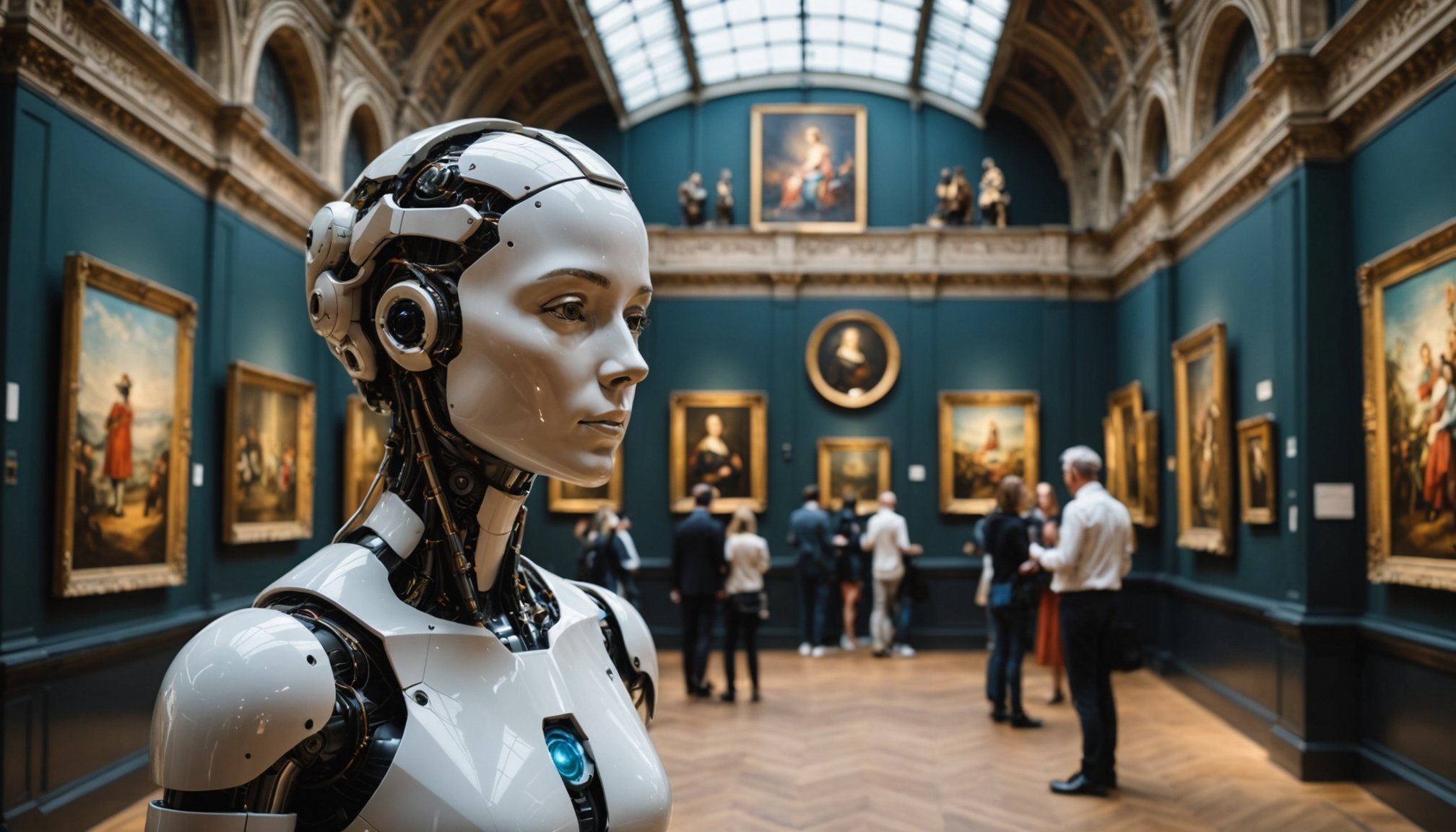Overview of AI Innovations in UK Museums
Recent years have witnessed significant AI innovations that are transforming how UK museums engage with their visitors. By incorporating artificial intelligence, museums are enhancing the visitor experience, ensuring that each visit is enriching and memorable. AI enriches exhibits with interactive elements and personalises tours based on individual preferences.
One remarkable advancement is the use of AI-driven virtual guides. These guides provide interactive, tailored tours that adapt to the visitor’s interests. For example, an art enthusiast and a history buff might receive totally different insights about the same exhibit.
Also to discover : Transforming city transportation: how ai enhances traffic management in the uk”s smart urban landscapes
AI technology also plays a critical role in making cultural experiences more accessible. By using sophisticated language translation tools, AI facilitates multilingual tours, allowing a diverse audience to engage fully with the exhibits.
Additionally, museums are leveraging AI to analyse visitor data. Through this analysis, they gain insights into visitor behaviours and preferences, enabling them to create more engaging exhibits designed to appeal to various interests. This not only attracts more visitors but also ensures returning visitors have fresh experiences.
Also to read : Revolutionizing telecom customer experience in the uk: harnessing the power of ai innovations
Therefore, by embracing AI innovations, UK museums are reshaping cultural experiences to be more inclusive and personalised, ensuring that each visitor leaves with a sense of discovery and inspiration.
Case Studies of Successful AI Implementations
Artificial Intelligence (AI) has significantly impacted museums worldwide, and the success stories of its applications continue to grow.
The British Museum
AI has transformed visitor experiences at the British Museum, featuring prominently through museum technology. It implemented virtual assistants and guided tours, enhancing interactive experiences. Visitors reported increased engagement and a deeper appreciation of exhibitions due to AI’s ability to provide detailed and contextually-rich information. These AI case studies highlight how technology can augment traditional storytelling, creating a more enriching atmosphere.
The Science Museum
The Science Museum utilised AI to personalise visits, tailor content, and suggest exhibits based on visitor preferences. This approach resulted in highly positive feedback, as guests appreciated the bespoke experience. AI applications here significantly boosted repeat visits, showcasing a successful alignment of technology with visitor needs. Notably, this case study emphasised the importance of understanding audience preferences for successful AI deployment in museums.
The Victoria and Albert Museum
At the Victoria and Albert Museum, AI-powered installations enabled interactive and immersive exhibitions. Visitors were encouraged to engage with art pieces dynamically, leading to long-lasting impressions and increased visitor numbers. The AI’s ability to adapt dynamically during exhibitions enabled unique, memorable experiences. This success story teaches valuable lessons about integrating museum technology into existing frameworks and developing a versatile visitor engagement model.
Benefits of AI Solutions for Museums
In recent years, museums have leveraged AI solutions to revolutionise the museum visitor experience. One of the most significant benefits of AI is its ability to offer enhanced personalisation. By analysing visitor data, AI can tailor experiences based on individual interests and previous visits. For instance, personalised tours can guide visitors through the museum, highlighting exhibits aligned with their preferences.
Furthermore, AI contributes to improved accessibility for diverse audiences. Through educational technology, museums can cater to visitors with different needs. For example, AI-powered audio guides can offer real-time translation into multiple languages and provide descriptive narrations for visually impaired visitors, ensuring that educational content is accessible to all.
Engagement with educational content is also improved via AI-driven interactive technologies. These tools not only make learning more engaging but also offer a platform for deeper exploration. Virtual reality exhibits, powered by AI, allow visitors to explore historical events or ancient civilizations in an immersive way. Additionally, AI chatbots can interact with visitors, answering questions and offering insights in real-time.
Overall, AI solutions offer museums the opportunity to create a dynamic and inclusive visitor experience, bridging the gap between traditional exhibits and cutting-edge technology.
Expert Opinions and Statistics
Expert insights play a crucial role in understanding the evolving landscape of museums in the age of technology. Museum curators and technology experts are unanimous in their belief that the integration of AI has revolutionised visitor experiences. They argue that AI not only personalises visits but enhances engagement in ways previously unimaginable.
Recent museum statistics illustrate the profound impact AI has had. For instance, museums employing AI-driven exhibits report a 30% increase in visitor satisfaction rates. This is attributed to interactive elements that allow visitors to engage deeply with exhibits, leading to more memorable experiences. Moreover, the data shows a substantial rise in overall visitor engagement, emphasising the tool’s effectiveness in drawing interest.
Looking ahead, experts predict further developments in AI for museums. Enhanced AI algorithms are expected to create even more dynamic and personalised experiences. Some foresee virtual reality (VR) integration to transport visitors to different historical periods or recreate extinct environments vividly. This forward-thinking approach highlights the transformative power of AI in shaping future museum experiences.
In summary, insights and statistics confirm that AI will continue to be a pivotal component, enriching museums and boosting visitor satisfaction and engagement significantly.
Challenges and Considerations
When integrating AI into museum practices, various AI challenges can emerge. Museums might face difficulties in adapting their existing systems to accommodate new technologies, requiring substantial investment in both infrastructure and staff training for efficient implementation. There’s also the risk of technical glitches that can disrupt the carefully curated visitor experience.
Ethical considerations are paramount. As museums leverage AI, they must ensure that technology is used responsibly. This means being transparent about how visitor data is collected and used, thereby maintaining visitor trust. Transparency fosters trust but requires careful communication strategies to assure patrons their privacy is respected.
Balancing this technology with traditional museum practices is another notable consideration. While AI enhances accessibility and personalisation, it should not overshadow the intrinsic value of physical artefacts and the tactile, immersive experiences they offer. Museums must navigate this balance to enrich visitor engagement without diminishing the authenticity of conventional displays.
Visitor trust hinges on this equilibrium; museums need to prioritise creating enriching experiences that blend both technological innovations and time-honoured traditions. By thoughtfully addressing these challenges, museums can successfully integrate AI, enhancing educational impact while respecting visitor expectations and cultural heritage.
Future of AI in the Museum Sector
The future trends in museums are increasingly shaped by AI advancements, poised to redefine how we experience cultural heritage. As technology propels forward, museum innovations promise transformative shifts, enriching the visitor’s journey like never before.
Emerging technologies on the horizon include AI-driven virtual tours, augmented reality (AR), and automated content curation, which can create personalised experiences for each visitor. These technologies enable museums to showcase their collections in novel ways, breaking geographical barriers and engaging a global audience.
A long-term vision for AI integration is critical in enhancing cultural heritage. By using AI to digitise, preserve, and interpret collections, museums ensure the longevity and accessibility of cultural artefacts. This is crucial for safeguarding heritage against natural and human threats, while also offering new educational opportunities.
The impact on the overall museum landscape is substantial. AI not only changes how exhibits are displayed but also reshapes visitor expectations. As AI becomes more prevalent, visitors anticipate interactive, tailored experiences that provide deeper insights. Therefore, museums must continually innovate to meet these evolving demands.
These AI advancements represent a thrilling and dynamic chapter in the museum sector, poised to create a more interactive, engaging, and inclusive cultural environment.






